
Ramanujan's 100-Year-Old Pi Formula That Hides the Secrets of the Universe.
SciTech Daily - December 8, 2025

Ramanujan's 100-Year-Old Pi Formula That Hides the Secrets of the Universe.
SciTech Daily - December 8, 2025
A new study reveals that Srinivasa Ramanujan's century-old formulas for calculating pi unexpectedly emerge within modern theories of critical phenomena, turbulence, and black holes
A Surprising Mathematical Pattern Was Found Hiding in Earth's History Science Alert - September 2, 2025



According to a recent study, events geologists use to distinguish transitions between geological chapters in Earth's story follow a hidden hierarchical pattern, one that could shed light on both past and future tumult. Geological time scales may look like tidy timelines in textbooks, but their boundaries tell a much more chaotic story.
The poetry of ancient math PhysOrg - August 20, 2025


Add zero and one to get one, one and one to get two, one and two to get three, two and three to get five. Most of us know this - that each successive number is the sum of the two numbers that came before it - as the Fibonacci sequence, named after a 12th-century Italian mathematician. But as early as 200 BCE, an Indian poet and mathematician named Acharya Pingala used that sequential concept to analyze poetry, and 7th-century scholar Virahanka later described it in more detail.
Khipu - Hair-based record-keeping system may have been used by Inca elites and commoners alike PhysOrg - August 18, 2025
Before databases and spreadsheets, people had to find other ways to keep track of information. One of the more interesting recording-keeping systems was the khipu - a cord made of human hair from which additional cords were hung with knots indicating decimal numbers. These khipu were common among elite individuals in the Inka empire in western South America. Some accounts of khipu use were given in chronicles of Spanish language colonial observers, which indicated that khipu were only used and created by elite male bureaucrats (called khipukamayuqs) at the time.
"Remarkable" Pattern Discovered Behind Prime Numbers, Math's Most Unpredictable Objects IFL Science - June 21, 2025

Last year, a trio of mathematicians found what seemed to be a kind of order in the primes – and it came from somewhere completely unexpected.
The Biggest Prime Number Ever Found Is a New Milestone in Science Science Alert - November 18, 2024
Imagine a number made up of a vast string of ones: 1111111…111. Specifically, 136,279,841 ones in a row. If we stacked up that many sheets of paper, the resulting tower would stretch into the stratosphere.
Is There Really A Link Between Math Skills And Musical Skills? Live Science - February 25, 2024
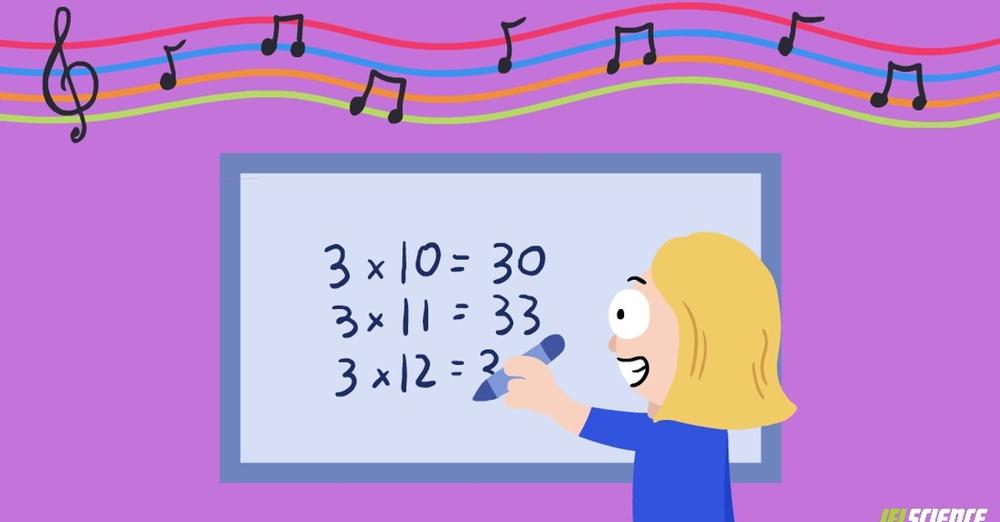
In the classical world, we have influential composer Philip Glass, who studied math and philosophy at the University of Chicago. Then there's pioneering astronomer and discoverer of Uranus William Herschel, who also managed to find time to compose a large catalog of musical works for a variety of instruments. And, perhaps the doyen of them all: Pythagoras himself. Although best known for the famous theorem that sent you to sleep at school (something something triangles?) and his slightly eccentric beliefs about beans, the so-called 'father of numbers' also made some of the first great strides in understanding the fundamentals of harmony that still apply in Western musical composition today.
World's oldest known decimal point discovered in merchant's notes from 1440s Italy Live Science - February 23, 2024
Decimal points are at least 150 years older than historians thought, according to newly unearthed notes from Venetian merchant Giovanni Bianchini, who practiced astrology in the 1440s.
Pythagorean Theorem Found On Clay Tablet 1,000 Years Older Than Pythagoras IFL Science - October 2, 2023
There is an ancient Babylonian tablet (by the catchy name of IM 67118) which uses the Pythagorean theorem to solve the length of a diagonal inside a rectangle. The tablet, likely used for teaching, dates from 1770 BCE - centuries before Pythagoras was born in around 570 BCE.
Formula Calculates Any Digit Of Pi, Nobody Noticed For Centuries IFL Science - August 17, 2023
The reason pi is able to capture our imagination like this is because it is an irrational number – in other words, its decimal expansion is never-ending and entirely random. It’s thought that any sequence of numbers you can possibly think of can be found somewhere in the expansion of pi, and yet knowing any particular sequence somewhere in the expansion tells you no information about which digit comes next.
Mathematics Has a Biological Origin, Study Reveals Science Alert - August 16, 2023
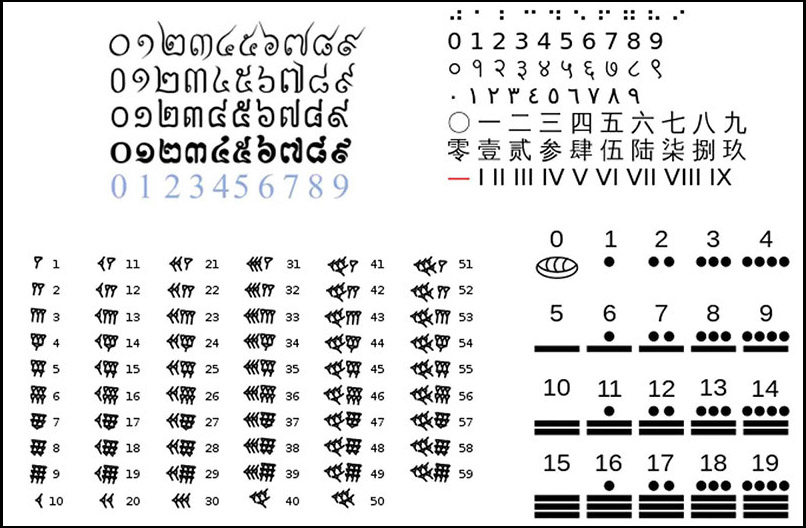
By stepping outside the box of our usual way of thinking about numbers, my colleagues and I have recently shown that arithmetic has biological roots and is a natural consequence of how perception of the world around us is organised.
X Marks The Unknown In Algebra - But X's Origins Are A Math Mystery IFL Science - August 7, 2023
Even though x is one of the least-used letters in the English alphabet, it appears throughout American culture - from Stan Lee’s X-Men superheroes to The X-Files TV series. The letter X often symbolizes something unknown, with an air of mystery that can be appealing - just look at Elon Musk with SpaceX, Tesla’s Model X, and now X as a new name for Twitter.
Proving Fermat’s Last Theorem: 2 Mathematicians Explain How Building Bridges Within The Discipline Helped Solve A Centuries-Old Mystery IFL Science - June 28, 2023
Beyond providing a satisfying resolution to a long-standing problem, Wiles’ work marks an important moment in the establishment of a bridge between two important, but seemingly very different, areas of mathematics. History demonstrates that many of the greatest breakthroughs in math involve making connections between seemingly disparate branches of the subject. These bridges allow mathematicians, like the two of us, to transport problems from one branch to another and gain access to new tools, techniques and insights.
Undeterred after three decades of looking, and with some assistance from a supercomputer, mathematicians have finally discovered a new example of a special integer called a Dedekind number Science Alert - June 28, 2023

Grasping the concept of a Dedekind number is difficult for non-mathematicians, let alone working it out. In fact, the calculations involved are so complex and involve such huge numbers, it wasn't certain that D(9) would ever be discovered.
Mathematicians Discovered a New 13-Sided Shape That Can Do Remarkable Things Science Alert - March 30, 2023
Computer scientists found the holy grail of tiles. They call it the "Einstein," one shape that alone can cover a plane without ever repeating a pattern. And all it takes for this special shape is 13 sides. In the world of mathematics, an "aperiodic monotile" - also known as an einstein based off a German phrase for one stone - is a shape that can tile a plane, but never repeat.
A group of mathematicians has unveiled a brand new 13-sided shape they've simply called 'the hat'. Don't let the rather mundane description fool you though. This hat (which looks a bit like a fedora) is next season's must-have fashion item, able to be tiled across a plane to create patterns that never repeat. Shapes like these are known as aperiodic monotiles, or einsteins. Slotted together, it's impossible to find a matching arrangement or orientation somewhere directly above or on the same horizon. The hat was first identified by non-professional mathematician and "shape hobbyist" David Smith from the UK. He did some tinkering in a shape generation program before moving to physical paper cut-outs.
Centuries-old 'impossible' math problem cracked using the strange physics of Schrodinger's cat Live Science - January 20, 2022
A math problem developed 243 years ago can be solved only by using quantum entanglement, new research finds. The mathematics problem is a bit like Sudoku on steroids. It's called Euler's officer problem, after Leonhard Euler, the mathematician who first proposed it in 1779. Here's the puzzle: You're commanding an army with six regiments. Each regiment contains six different officers of six different ranks. Can you arrange them in a 6-by-6 square without repeating a rank or regiment in any given row or column? Euler couldn't find such an arrangement, and later computations proved that there was no solution. In fact, a paper published in 1960 in the Canadian Journal of Mathematics used the newfound power of computers to show that 6 was the one number over 2 where no such arrangement existed.
If you understand Simulation Theory that all things are created by the same algorithmic patterns - you have probably been drawn to the following
Sacred Geometry for those who enjoy a metaphysical spin on things
11:11 Phenomenon and Digital Time Codes
Fibonacci Sequence Codes that Create Our Reality
Gold Mean, Golden Ratio, Golden Proportion which takes us to the Great Pyramid, grid and ley lines, Vitruvian Man, and much more.
Binary Code (ones and zeros - how our brain processes, who we really are)
It's 2022 - Time to Understand that what we believe are our real experiences are codes that are accelerating to closure. Tick tock. Close your eyes? See anything interesting?
What if Math Is a Fundamental Part of Nature, Not Something Humans Came Up With? Science Alert - January 3, 2022

But there's another school of thought which suggests math is actually what the world is made of - that nature follows the same simple rules, time and time again, because mathematics underpins the fundamental laws of the physical world. This would mean math existed in nature long before humans invented it
9 equations that changed the world: Pythagorean theorem, F = ma and the law of gravity, Wave equation, Fourier's equations, Maxwell's equations, E = mc^2, Friedmann's equations, Shannon's information equation, May's logistic map Live Science - December 22, 2021
Mathematical equations offer unique windows into the world. They make sense of reality and help us see things that haven't been previously noticed. So it’s no surprise that new developments in math have often gone hand in hand with advancements in our understanding of the universe. Here, we take a look at nine equations from history that have revolutionized how we look at everything from tiny particles to the vast cosmos.
I love this. Answers will come from technology. It's all binary code including us ... ones and zeroes.
AI Is Discovering Patterns in Pure Mathematics That Have Never Been Seen Before Science Alert - December 4, 2021
While mathematicians have been using computers to discover patterns for decades, the increasing power of machine learning means that these networks can work through huge swathes of data and identify patterns that haven't been spotted before.
Reality is an algorithm set in motion through linear time.
Did Humans Invent Mathematics, or Is It a Fundamental Part of Existence? Science Alert - November 24, 2021

Many people think that mathematics is a human invention. To this way of thinking, mathematics is like a language: it may describe real things in the world, but it doesn't 'exist' outside the minds of the people who use it.
Pi calculated to a record-breaking 62.8 trillion digits Live Science - October 8, 2021
Researchers in Switzerland are set to break the record for the most precise value of the mathematical constant pi, after using a supercomputer to calculate the famous number to its first 62.8 trillion decimal places.Pi is the ratio of a circle's circumference to its diameter. The name "pi" comes from the 16th letter in the Greek alphabet and has been used by mathematicians to represent the constant since the early 18th century. The first 10 digits of pi are 3.141592653, but the constant is what is known as an irrational number, meaning that it cannot be expressed as a common fraction and has an infinite number of decimal places.
Scientists Just Broke The Record For Calculating Pi, And Infinity Never Felt So Close Science Alert - August 17, 2021
Swiss researchers have calculated the mathematical constant pi to a new world-record level of exactitude, hitting 62.8 trillion figures using a supercomputer. The calculation took 108 days and nine hours using a supercomputer.
This 3,700-Year-Old Tablet Shows The Oldest Known Example of Applied Geometry Science Alert - August 5, 2021
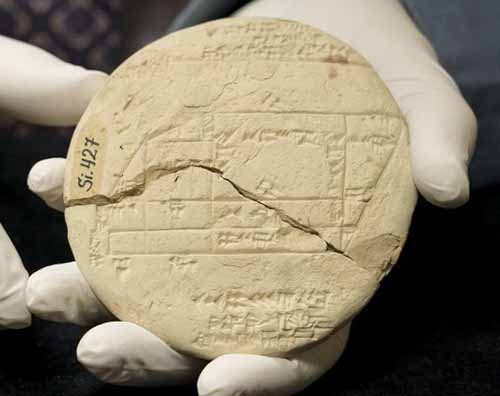
An ancient fragment of clay tablet dating back to 3,700 years ago, during the Old Babylonian period, contains what is now the oldest known example of applied geometry, a mathematician has discovered. That's more than a millennium prior to the birth of Pythagoras.
Rewriting the history of mathematics: Oldest example of applied geometry is discovered on a 3,700-year-old clay tablet using maths attributed to Pythagoras 1,000 years later Daily Mail - August 4, 2021
The tablet, known as Si.427 was discovered in the late 19th Century in central Iraq, but its significance had remained unknown until it was analyed in more detail by mathematicians from the University of New South Wales in Sydney, Australia. The tablet dates from the Old Babylonian period, which was between 1900 to 1600 BC, and includes maths that was used by surveyors to define land boundaries.
New AI 'Ramanujan Machine' uncovers hidden patterns in numbers Live Science - February 14, 2021

A new artificially intelligent "mathematician" known as the Ramanujan Machine can potentially reveal hidden relationships between numbers.
The "machine" consists of algorithms that seek out conjectures, or mathematical conclusions that are likely true but have not been proved. Conjectures are the starting points of mathematical theorems, which are conclusions that have been proved by a series of equations.
Two Mathematicians Just Solved a Decades-Old Math Riddle - and Possibly the Meaning of Life Live Science - September 9, 2019
In Douglas Adams' sci-fi series "The Hitchhiker's Guide to the Galaxy," a pair of programmers task the galaxy's largest supercomputer with answering the ultimate question of the meaning of life, the universe and everything. After 7.5 million years of processing, the computer reaches an answer: 42. Only then do the programmers realize that nobody knew the question the program was meant to answer. Now, in this week's most satisfying example of life reflecting art, a pair of mathematicians have used a global network of 500,000 computers to solve a centuries-old math puzzle that just happens to involve that most crucial number: 42.
Good at math? It means little if you're not confident PhysOrg - September 9, 2019
In two studies, researchers found that the key to success in personal finances and dealing with a complex disease was a match between a person's math abilities and how comfortable and assured he or she felt using those skills.
Physicists puzzled by strange numbers that could explain reality - Physicists discover complex numbers called octonions that work in 8 dimensions Big Think - January 10, 2019
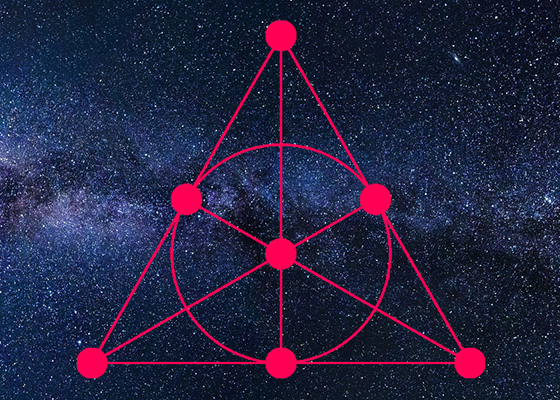
Understanding octonions can lead to a new model of physics. Is our reality, including its forces and particles, based on the strange properties of numbers with eight dimensions called "octonions"? A physicist thinks so, having found a way to expand 40-year-old research to reach surprising new directions.
This Huge New Prime Number Is a Very Big Deal Live Science - January 8, 2018
So how big is this number? A full 23,249,425 digits long - nearly 1 million digits longer than the previous record holder. If someone started writing it down, 1,000 digits a day, today (Jan. 8), they would finish on Sept. 19, 2081, according to some back-of-the-napkin calculations at Live Science.
'Anumeric' People: When Languages Have No Words for Numbers Live Science - April 30, 2017
Numbers do not exist in all cultures. There are numberless hunter-gatherers embedded deep in Amazonia, living along branches of the world's largest river tree. Instead of using words for precise quantities, these people rely exclusively on terms analogous to "a few" or "some." In contrast, our own lives are governed by numbers. As you read this, you are likely aware of what time it is, how old you are, your checking account balance, your weight and so on. The exact (and exacting) numbers we think with impact everything from our schedules to our self-esteem. But, in a historical sense, numerically fixated people like us are the unusual ones. For the bulk of our species' approximately 200,000-year lifespan, we had no means of precisely representing quantities. What's more, the 7,000 or so languages that exist today vary dramatically in how they utilize numbers. Speakers of anumeric, or numberless, languages offer a window into how the invention of numbers reshaped the human experience. In a new book, I explore the ways in which humans invented numbers, and how numbers subsequently played a critical role in other milestones, from the advent of agriculture to the genesis of writing.
New largest prime number found PhysOrg - January 20, 2016
A team at the University of Central Missourihas announced they have found the largest prime number ever - it is 274,207,281 - 1, it has over 22 million digits. The new record has broken the old record by approximately 5 million digits.
Tutoring relieves math anxiety, changes fear circuits in children, study finds PhysOrg - September 8, 2015
Anxiety about doing math problems can be relieved with a one-on-one math tutoring program, according to a new study. Even if they are good at math, many children feel anxious about doing math problems. For some, the anxiety persists throughout life, discouraging them from pursuing advanced math and science classes as well as careers that rely on mathematical expertise. Yet almost no attention has been paid to how to help alleviate this problem.
Origami: Mathematics in Creasing Live Science - January 7, 2015
Origami is the ancient Japanese art of paper folding. One uncut square of paper can, in the hands of an origami artist, be folded into a bird, a frog, a sailboat, or a Japanese samurai helmet beetle. Origami can be extraordinarily complicated and intricate. The art of origami has been going through a renaissance over the past 30 years, with new designs being created at ever-increasing levels of complexity. It’s no coincidence that this rise in origami complexity has emerged at the same time scientists, mathematicians and origami artists themselves have been discovering more and more of the mathematical rules that govern how paper folding works.
Who's afraid of math? Study finds some genetic factors Science Daily - March 18, 2014
A new study of math anxiety shows how some people may be at greater risk to fear math not only because of negative experiences, but also because of genetic risks related to both general anxiety and math skills. The results don't mean that math anxiety can be blamed solely or even mostly on genetic factors, the researchers emphasized. In this study, genetic factors explained about 40 percent of the individual differences in math anxiety.
After 400 Years, Mathematicians Find a New Class of Solid Shapes Live Science - February 19, 2014
The work of the Greek polymath Plato has kept millions of people busy for millennia. A few among them have been mathematicians who have obsessed about Platonic solids, a class of geometric forms that are highly regular and are commonly found in nature. Since Plato's work, two other classes of equilateral convex polyhedra, as the collective of these shapes are called, have been found: Archimedean solids (including truncated icosahedron) and Kepler solids (including rhombic polyhedra). Nearly 400 years after the last class was described, researchers claim that they may have now invented a new, fourth class, which they call Goldberg polyhedra. Also, they believe that their rules show that an infinite number of such classes could exist.
Mathematics: Why the brain sees maths as beauty BBC - February 13, 2014
Brain scans show a complex string of numbers and letters in mathematical formulae can evoke the same sense of beauty as artistic masterpieces and music from the greatest composers. Mathematicians were shown "ugly" and "beautiful" equations while in a brain scanner at University College London. The same emotional brain centres used to appreciate art were being activated by "beautiful" maths.
What's the Universe Made Of? Math, Says Scientist Live Science - January 30, 2014
Brooklyn, NY - Scientists have long used mathematics to describe the physical properties of the universe. But what if the universe itself is math? That's what MIT cosmologist Max Tegmark believes. In Tegmark's view, everything in the universe - humans included - is part of a mathematical structure. All matter is made up of particles, which have properties such as charge and spin, but these properties are purely mathematical, he says. And space itself has properties such as dimensions, but is still ultimately a mathematical structure. "If you accept the idea that both space itself, and all the stuff in space, have no properties at all except mathematical properties," then the idea that everything is mathematical "starts to sound a little bit less insane," Tegmark said in a talk given Jan. 15 here at The Bell House. The talk was based on his book "Our Mathematical Universe: My Quest for the Ultimate Nature of Reality" (Knopf, 2014). "If my idea is wrong, physics is ultimately doomed," Tegmark said. But if the universe really is mathematics, he added, "There's nothing we can't, in principle, understand."
Listen to Max's interview The Guardian - February 3, 2014
Donated Chinese bamboo strips turn out to be ancient multiplication table PhysOrg - January 9, 2014
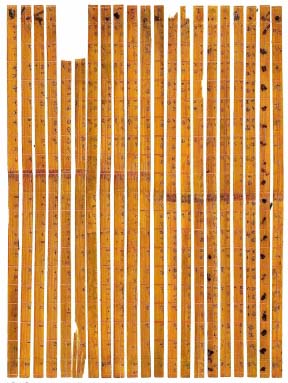
Researchers at Tsinghua University in China are reporting that a subset of bamboo strips donated to the university five years ago has been found to make up an ancient Chinese multiplication table. Dated back to 2,300 years ago (circa 305 B.C.), the table represents the oldest-known such device that computes in base 10 - ancient Babylonian tables dating back 4000 years were base 60. The bamboo strips were part of a much larger collection of very old and partially decomposed bamboo strips, all of which had writing on the back.
Some Polynesian islanders combined binary and decimal math PhysOrg - December 17, 2013

When we think of binary math, we think of computers. A number system with only two digits makes calculations quick and easy. However, binary numbers can be very long and, therefore, unwieldy. While binary numbers might be great for machines, decimal numbers are shorter and more comfortable for people to use. A system that combines the benefits of base 2 and base 10 could be ideal.
Largest Prime Number Discovered Live Science - February 6, 2013
The largest prime number yet has been discovered - and it's 17,425,170 digits long. The new prime number crushes the last one discovered in 2008, which was a paltry 12,978,189 digits long. The number - 2 raised to the 57,885,161 power minus 1 - was discovered by University of Central Missouri mathematician Curtis Cooper as part of a giant network of volunteer computers devoted to finding primes, similar to projects like SETI@Home, which downloads and analyzes radio telescope data in the Search for Extraterrestrial Intelligence(SETI). The network, called the Great Internet Mersenne Prime Search (GIMPS) harnesses about 360,000 processors operating at 150 trillion calculations per second. This is the third prime number discovered by Cooper.
The World's Most Beautiful Equations Live Science - January 29, 2013
General relativity
Mathematical equations aren't just useful - many are quite beautiful. And many scientists admit they are often fond of particular formulas not just for their function, but for their form, and the simple, poetic truths they contain. While certain famous equations, such as Albert Einstein's E = mc^2, hog most of the public glory, many less familiar formulas have their champions among scientists. LiveScience asked physicists, astronomers and mathematicians for their favorite equations; here's what we found:
The Life of Pi, and Other Infinities New York Times - December 31,, 2012
On this day that fetishizes finitude, that reminds us how rapidly our own earthly time share is shrinking, allow me to offer the modest comfort of infinities. Yes, infinities, plural. The popular notion of infinity may be of a monolithic totality, the ultimate, unbounded big tent that goes on forever and subsumes everything in its path — time, the cosmos, your complete collection of old Playbills. Yet in the ever-evolving view of scientists, philosophers and other scholars, there really is no single, implacable entity called infinity. Instead, there are infinities, multiplicities of the limit-free that come in a vast variety of shapes, sizes, purposes and charms. Some are tailored for mathematics, some for cosmology, others for theology; some are of such recent vintage their fontanels still feel soft. There are flat infinities, hunchback infinities, bubbling infinities, hyperboloid infinities. There are infinitely large sets of one kind of number, and even bigger, infinitely large sets of another kind of number.
Pi Wikipedia

Pi is a mathematical constant that is the ratio of a circle's circumference to its diameter, and is approximately equal to 3.14159 and number that goes on infinitely.
 Stanford mathematician: In reality, simulation is key to math education PhysOrg - February 22, 2010
Stanford mathematician: In reality, simulation is key to math education PhysOrg - February 22, 2010
A massively multiplayer online game requiring players to employ mathematical concepts could revolutionize the teaching of mathematics at the middle school level, according to Stanford mathematician Keith Devlin. That's the age when math and science proficiency plummets among U.S. students. Devlin says the game project would be so complex and expensive that the federal government would likely have to spearhead it. But, he said, a pilot project showed such a game would be doable.
Few Gender Differences in Math Abilities, Worldwide Study Finds Science Daily - January 7, 2010
Girls around the world are not worse at math than boys, even though boys are more confident in their math abilities, and girls from countries where gender equity is more prevalent are more likely to perform better on mathematics assessment tests, according to a new analysis of international research.
 Audio slideshow: The art of mathematics BBC - September 17, 2008
Audio slideshow: The art of mathematics BBC - September 17, 2008
To the untrained eye, these vivid images might appear to be random sets of colorful swirls and circles. But they are in fact precise visual representations of mathematical theory known as dynamical systems.
Numbers follow a surprising law of digits, and scientists can't explain why PhysOrg - May 11, 2007
Does your house address start with a 1? According to a strange mathematical law, about 1/3 of house numbers have 1 as their first digit. The same holds true for many other areas that have almost nothing in common: the Dow Jones index history, size of files stored on a PC, the length of the world’s rivers, the numbers in newspapers’ front page headlines, and many more.
248-dimension math puzzle solved BBC - March 19, 2007
An international team of mathematicians has detailed a vast complex numerical "structure" which was described more than a century ago. Mapping the 248-dimensional structure, called E8, took four years of work and produced more data than the Human Genome Project, researchers said. E8 is a "Lie group", a means of describing symmetrical objects. The team said their findings may assist fields of physics which use more than four dimensions, such as string theory. Lie groups were invented by the 19th Century Norwegian mathematician Sophus Lie (pronounced "Lee").
Mathematicians solve old problem that may have new applications PhysOrg - December 26, 2005
A twisted soap bubble with a handle? If you find that hard to visualize, it's understandable. Experts had thought for more than 200 years that such a structure was not even mathematically possible. But no longer.
Greatest maths problem 'solved' BBC - June 10, 1004
A mathematician at Purdue University in the US claims to have proved the Riemann Hypothesis - called the greatest unsolved problem in maths. The hypothesis concerns prime numbers and has stumped the world's mathematicians for more than 150 years. Now, Professor Louis De Branges de Bourcia has posted a 23-page paper on the internet detailing his attempt at a proof.
Prime number breakthrough BBC - April 4, 2003
A pair of mathematicians has made a breakthrough in understanding so-called prime numbers, numbers that can only be divided by themselves and one. Other mathematicians have described the advance as the most important in the field in decades.
How random is Pi? BBC - July 23, 2002
Mathematicians have achieved a major step towards answering the question of whether numbers like pi and other mathematical constants are truly random and for the first time linked number theory with chaos theory.
It is not just a mathematical curiosity they say. Proving that pi never repeats itself would be a major advance in our theory of numbers. It may also allow the construction of unbreakable codes based on long sequences of random numbers. The value of pi is known to 500 billion places. No cyclic patterns have been found and if mathematicians are correct none will ever be found no matter how many digits are calculated.
The largest prime number yet discovered has just been revealed to the world BBC - December 5, 2001
>
The prime number - a number that can only be divided by one and itself - was discovered by Michael Cameron, a 20-year-old Canadian participant in a mass computer project known as the Great Internet Mersenne Prime Search (Gimps). Mersenne primes are important for the theory of numbers and they may help in developing unbreakable codes and message encryptions. The Gimps project spent 13,000 years of computer time to find the new prime number.